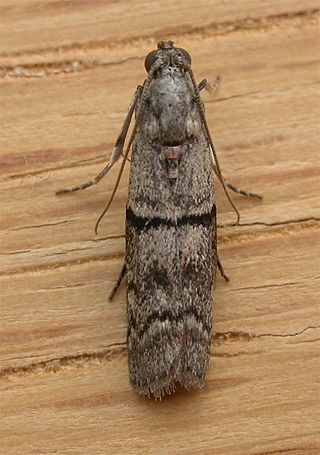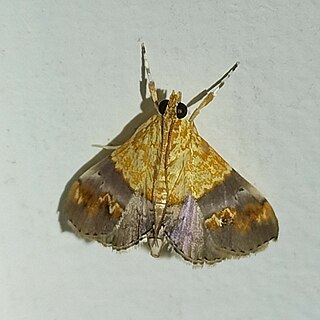
The Sesiidae or clearwing moths are a diurnal moth family in the order Lepidoptera known for their Batesian mimicry in both appearance and behaviour of various Hymenoptera.

The Pyralidae, commonly called pyralid moths, snout moths or grass moths, are a family of Lepidoptera in the ditrysian superfamily Pyraloidea. In many classifications, the grass moths (Crambidae) are included in the Pyralidae as a subfamily, making the combined group one of the largest families in the Lepidoptera. The latest review by Eugene G. Munroe and Maria Alma Solis retain the Crambidae as a full family of Pyraloidea.

The Indianmeal moth, also spelled Indian meal moth and Indian-meal moth, is a pyraloid moth of the family Pyralidae. Alternative common names are hanger-downers, weevil moth, pantry moth, flour moth or grain moth. The almond moth and the raisin moth are commonly confused with the Indian-meal moth due to similar food sources and appearance. The species was named for feeding on Indian meal or cornmeal, and does not occur natively in India. It is also not to be confused with the Mediterranean flour moth, another common pest of stored grains.

The almond moth or tropical warehouse moth is a small, stored-product pest. Almond moths infest flour, bran, oats, and other grains, as well as dried fruits. It belongs to the family of snout moths (Pyralidae), and more specifically to the tribe Phycitini of the huge snout moth subfamily Phycitinae. This species may be confused with the related Indian mealmoth or the Mediterranean flour moth, which are also common pantry pests in the same subfamily.

Castniidae, or castniid moths, is a small family of moths with fewer than 200 species: The majority are Neotropical with some in Australia and a few in south-east Asia. These are medium-sized to very large moths, usually with drab, cryptically marked forewings and brightly coloured hindwings. They have clubbed antennae and are day flying, and are often mistaken for butterflies. Indeed, some previous classification systems placed this family within the butterflies or skippers. The Neotropical species are commonly known as giant butterfly-moths, the Australian and Asian species as sun moths. The larvae are internal feeders, often on roots of epiphytes or on monocotyledons.
Arotrophora arcuatalis, commonly known as banksia boring moth or rarely banksia moth, is a species of Australian tortrid moth best known as a pest of Banksia.

Agrotera is a genus of snout moths in the subfamily Spilomelinae of the family Crambidae. It is the type genus of the tribe Agroterini and currently comprises 28 species distributed in the Afrotropical, Palearctic, Indomalayan and Australasian realm.

Cryptophlebia ombrodelta, the litchi fruit moth or macadamia nut borer, is a moth of the family Tortricidae. The species was first described by Oswald Bertram Lower in 1898. It is native to India, Sri Lanka, Nepal, Indonesia, China, Taiwan, Vietnam, Thailand, western Malaysia, New Guinea, the Philippines, Japan, Guam, the Caroline Islands, Australia and has been introduced to Hawaii.

Cadra is a genus of small moths belonging to the family Pyralidae. The genus Ephestia is closely related to Cadra and might be its senior synonym. Several of these moths are variously assigned to one or the other genus, in particular in non-entomological sources. Cadra and Ephestia belong to the huge snout moth subfamily Phycitinae, and therein to the tribe Phycitini.

The Phycitinae are a subfamily of snout moths. Even though the Pyralidae subfamilies are all quite diverse, Phycitinae stand out even by standards of their family: with over 600 genera considered valid and more than 4000 species placed here at present, they unite up more than three-quarters of living snout moth diversity. Together with the closely related Epipaschiinae, they are apparently the most advanced lineage of snout moths.
Cadra acuta is a species of snout moth in the genus Cadra. It was described by Marianne Horak in 1994. It is found in the Northern Territory as well as on the Cape York Peninsula in Australia.

Cadra calidella, the dried fruit or date moth, is a species of snout moth in the genus Cadra and commonly mistaken for the species Cadra figulilella. It thrives in warmer conditions and is found primarily in Mediterranean countries, although it can also be found in Central Asia, Kazakhstan, Transcaucasia, Caucasus, and the western part of Russia. It feeds on dried fruits, carobs, nuts and seeds, hence earning its colloquial name. This diet damages the food industry, and it is a common storage pest. Because of this, much research has been done to study ways to limit its reproduction rate and population size. It was first described by Achille Guenée in 1845.
Cadra rugosa is a species of snout moth in the genus Cadra. It was described by Marianne Horak in 1994. It is found in central Australia.

Cadra reniformis is a species of snout moth in the genus Cadra. It was described by Marianne Horak in 1994. It is found along the northern coast of Australia from Townsville to Darwin, mainly in monsoon forest.
Cadra perfasciata is a species of snout moth in the genus Cadra. It was described by Marianne Horak in 1994. It is found in the southern arid areas of Australia, on both sides of the Nullarbor Plain.

The Phycitini are a tribe of moths of the family Pyralidae.

Tetracona amathealis is a species of snout moth in the subfamily Spilomelinae of the family Crambidae. It was described by Francis Walker in 1859 based on material collected at Moreton Bay in Queensland, Australia. It is found in New Guinea and Australia, where it has been recorded in Queensland, northern New South Wales and Western Australia. The species was formerly placed in the genus Agrotera, but in a recent taxonomic revision it was transferred back to the re-instated genus Tetracona, of which it is the type species.

Nistra is a genus of snout moths in the family Crambidae. It is monotypic, being represented by the single species Nistra coelatalis, which was formerly included in the genus Agrotera.
Marianne Horak is a Swiss-Australian entomologist who specialises in Australian Lepidoptera, particularly the phycitine and tortricid moths, and is considered one of the worldwide leading experts on the systematics of Tortricidae.













